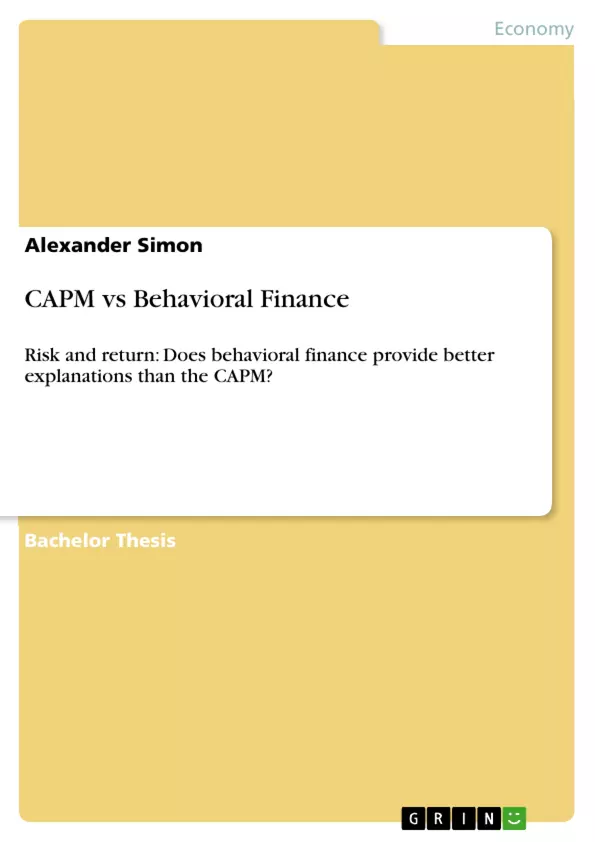“The chance to win is overestimated by all people. The chance to lose is underestimated by most people.” was already formulated by the moral philosopher and famous economist Adam Smith in his book “Wealth of Nations” in 1776. Two centuries later the behavioural economist Daniel Kahneman confirmed the notion that in situations with uncertainty people are inclined to biased decision-making. Actual tests of the CAPM on stock data confirmed that the market premium as a single factor may be insufficient to explain stock returns completely. Stambough (1982) among many others found a positive relation between beta and average return, however, it was “too flat” and the intercept was greater than a risk-free bond1. Other
effects were observed that could not be explained by the market premium alone; these “anomalies” such as the size factor2, book-to-market (“BTM”) factor3 and momentum factor4 among others led to the development of more extensive models. These models were in some respects more accurate than the CAPM in predicting future returns;
however, it remained unclear why these factors actually matter.
However, behavioural finance is no magic bullet for valuation of risk and predictability of returns. Although behavioural finance may explain the occurrence of factors relating to size and type of the firm, it does not provide accurate estimation techniques to enhance return predictability. Moreover, Beechey et al. (2000) underlines 33 The Institute of Behavioral Finance 20 that EMH still validates as a reasonable starting point for tests and research. Furthermore 80% of managers still use the CAPM to calculate the cost of equity capital
(Brav et al., 2005). In order to capture the “real” world, however, behavioral finance explains many anomalies, which were then incorporated in multifactor models. Despite the importance of the CAPM as a milestone in financial theory, these multifactor models
have been more accurate in predicting returns, and tend to be superior to a single-factor model.
Inhaltsverzeichnis (Table of Contents)
- Introduction
- The CAPM and the Efficient Market Hypothesis
- Evidence of CAPM Anomalies
- Modern Finance: Alternative Asset Pricing Models
- Inter-temporal Asset Pricing Model - ICAPM
- International Asset Pricing Model - IAPM
- Multifactor Asset Pricing Models: Fama-French and Carhart
- Influence of Psychology on Risk and Return
- Prospect Theory
- Heuristics, Biases and Emotions
- Irrationality and Overreaction
- Behavioral Finance versus CAPM
- Conclusion
- References
Zielsetzung und Themenschwerpunkte (Objectives and Key Themes)
This paper aims to analyze the current research in behavioral finance and its implications for the Capital Asset Pricing Model (CAPM). The paper explores the limitations of the CAPM and examines alternative asset pricing models. It also investigates how psychological factors such as biases, emotions, and heuristics influence investor decision-making. Key themes of the paper include:- The CAPM and its limitations
- Evidence of CAPM anomalies
- Alternative asset pricing models
- Behavioral finance and its explanations for investor behavior
- The impact of psychological factors on risk and return
Zusammenfassung der Kapitel (Chapter Summaries)
- Introduction: This chapter introduces the concept of behavioral finance and its relevance to understanding risk and return in the context of the CAPM. It highlights the limitations of traditional finance models in explaining real-world investment decisions and emphasizes the importance of incorporating psychological factors into financial models.
- The CAPM and the Efficient Market Hypothesis: This chapter provides an overview of the CAPM and its underlying assumptions. It explains the model's core principle of relating risk and return through beta, a measure of sensitivity to market movements. The chapter also discusses the Efficient Market Hypothesis (EMH) and its implications for asset pricing.
- Evidence of CAPM Anomalies: This chapter examines the empirical evidence that challenges the CAPM's validity. It discusses observed anomalies such as the size effect, book-to-market effect, and momentum effect, which suggest that the market premium alone may not fully explain stock returns.
- Modern Finance: Alternative Asset Pricing Models: This chapter explores alternative asset pricing models that attempt to address the limitations of the CAPM. It delves into models such as the Inter-temporal Asset Pricing Model (ICAPM), the International Asset Pricing Model (IAPM), and multifactor models like Fama-French and Carhart. These models aim to incorporate additional factors, such as inflation and global market conditions, to improve their predictive power.
- Influence of Psychology on Risk and Return: This chapter delves into the psychological foundations of behavioral finance, examining how biases, emotions, and heuristics affect investor decision-making. It discusses concepts such as prospect theory, which explains how investors perceive risk and make choices in situations with uncertainty.
Schlüsselwörter (Keywords)
The key concepts and terms explored in this paper include behavioral finance, Capital Asset Pricing Model (CAPM), Efficient Market Hypothesis (EMH), risk and return, psychological factors, anomalies, alternative asset pricing models, prospect theory, heuristics, biases, and emotions. These terms represent the core themes and research focus of the paper, highlighting the intersection of finance, psychology, and investment decision-making.- Quote paper
- Alexander Simon (Author), 2007, CAPM vs Behavioral Finance, Munich, GRIN Verlag, https://www.grin.com/document/196571



